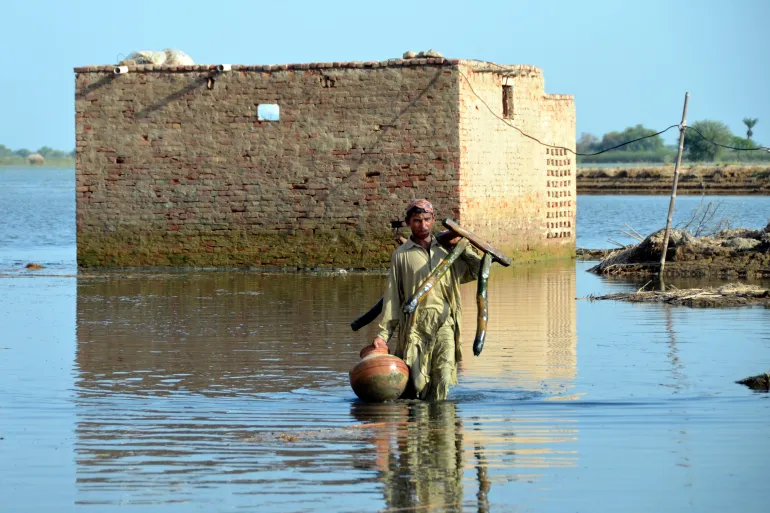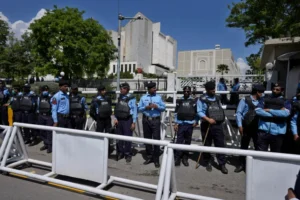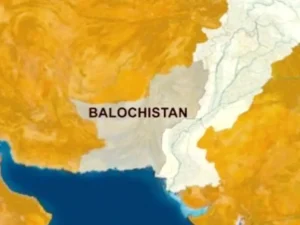The effects of climate change have put many countries at peril, and the risk is gradually increasing for developing nations. Climate change has the potential to cause broad and significantly adverse cycles for livelihoods and health. Because of this catastrophic challenge, South Asia has become increasingly disaster-prone. The global climate disaster endangers the health and economic security of the people of Pakistan too. Because of its geographical diversity and diverse tropical, continental climate (hot summers and chilly winters), the country is already vulnerable to many climate and weather-related catastrophic events. Pakistan is also prone to persistent heatwaves and droughts, riverine and catastrophic floods, landslides, and sea storms or cyclones.
Pakistan currently ranks as the world’s fifth most climate-vulnerable country.
According to the Global Climate Risk Index, Pakistan currently ranks as the world’s fifth most climate-vulnerable country, having lost approximately 10,000 lives and suffered economic damages worth USD 3.8 billion during the period from 1999 to 2018. Pakistan’s rainfall pattern has been complicated throughout its history. The early twentieth century had a sustained reduction in yearly rainfall, however since 1960, there has been a minor increase. At the same time, the frequency of heavy rainfall events has grown, as has the number of hot days in Pakistan each year.
Pakistan is a low to middle-income state with an agricultural economy. Climate-sensitive land, water, and forest resources remain critical to the country’s welfare and food security. Agriculture is a significant source of income for 42% of the population. Almost 90% of agriculture is dependent on irrigated water from the glacier-fed Indus River and its tributaries. Climate change has accelerated the rate of glacier melt, while increasing the likelihood of glacier lake outburst floods (GLOF) and flash floods downstream.
The flow of the River Indus is being altered by faster glacier melt, rising temperatures, shifting seasons, and variable rainfall patterns, all of which will have an increasing impact on agricultural activity, food production, and livelihood. Higher evaporation rates raise the demand for irrigation water. Wheat and Basmati Rice yields are expected to drop, perhaps driving output northward, depending on water availability.
Pakistan saw 126 heatwaves, an average of seven each year, with an increasing trend.
In August 2022, massive monsoon rains caused the most destructive floods in Pakistan’s history, which affected more than 33 million people. Statistics from the 2010 floods, show the devastation of 20 million people, who lost their homes, suffered injuries, or went missing. Similarly, another flood in Pakistan in 2012, caused devastating damages. Similarly, from 1997 to 2015, Pakistan saw 126 heatwaves, an average of seven each year, with an increasing trend.
Also Read: Floods and Climate Change Adaptation in Pakistan
According to estimates, more than 65,000 people were hospitalized with heatstroke during Pakistan’s 2015 heatwave, putting a large portion of the population at risk. In the last 30 years, the average number of heat wave days each year, has grown roughly fivefold. Smog is another big concern in Pakistan’s industrialized Eastern Punjab area, where the provincial capital, Lahore, is constantly polluted with smoke during the winters.

Geopolitical opponents are no longer the lone threat, but rather one of several elements that might put at risk the state. Climate change has emerged as a critical non-traditional security domain, posing significant challenges to Pakistan’s security. The rapidly changing environment poses a significant challenge and hazard to the state apparatus, as well as an increased security threat to Pakistan. National security must now be examined via comprehensive national security in which climate security is central to identify Pakistan’s most critical and grave concerns. Poverty and unemployment rates escalate, when more people lose their breadwinners or become climate refugees. \Violence against women tends to increase, as does the likelihood of human trafficking.
Children, particularly young girls, drop out of school due to destroyed infrastructure. People have less access to food and clean water, sickness rates rise, and quality of life suffers—all of which are cross-sectoral issues. Pakistan should tackle these weather-related catastrophes as a full-fledged national security crisis before they exacerbate strife and add to the country’s already daunting issues. Our planet is experiencing glaciers melting, rising floods, wildlife extinctions, catastrophic weather occurrences, and so on.
Our generation is the first to notice its early warning signs and the last to have the opportunity to prevent it from happening. Climate change causes crises that not only affect the country through natural catastrophes but also offer difficulties to the military in different ways. Changes in climate patterns such as glacier melting affect the troops’ training, movement, deployment and logistics. Similarly, glacier melting results in the rise of sea level, which poses a significant threat to naval vessels and infrastructure. The crisis induced by the phenomenon of global warming also results in significant life losses to military personnel, both junior and senior ranks, during rescue operations.
Pakistan must take control of its problems if it is to avoid dangers turning into disasters. Financial constraints in developing nations are one of the major barriers to climate change adaptation but the United Nations system introduced the Adaptation Fund in 2001 specifically to provide such support, but it appears to have dried up for various reasons. Pakistan developed its National Climate Change Policy in 2012, which addresses the wide concerns that the country confronts as a result of climate change, including policy recommendations for water, agriculture and livestock, forestry, and bio-diversity.
This policy was later updated in 2021 but much needs to be done to implement the policy in its letter and spirit. One achievement that Pakistan has gained by executing its ‘Billions of Trees Tsunami Project’ under auspices Ministry of Climate Change. Pakistan also stands on its commitment to the reduction of carbon emissions. As per the data collected in 2019, Pakistan stands far behind India, China and Russia in Carbon emissions as its Carbon emission rate is 0.86 Metric tons, whereas India stands at 1.78 Metric tons, China at 7.61 Metric tons and Russia at 11.80 Metric tons.
The amount of Carbon emissions these countries are producing is putting Pakistan in a hazardous position where it has to face the catastrophe of climate change every year. Climate change is the one of the major threats to Pakistan’s national security which needs to be addressed timely. Pakistan in collaboration with neighboring states needs to adopt some policy measures to deal with the upcoming challenges to avoid loss to humans and property.
The opinions shared in this article reflect the author’s personal views and do not necessarily align with the institution’s official stance.
Sara Nazir is an Islamabad-based researcher with a background in Strategic Studies & area of interest is non-traditional warfare. She can be reached on saranazeer2@gmail.com & @SaraNazir13 (on X).




